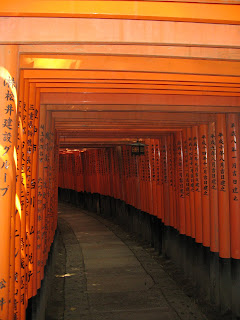


Finishing off in Tokyo, there was still a lot to see. These shots include Senso-ji temple, a traditional Shinto wedding at the Meiji Shrine, and some Harajuku girls who look as if they've dropped acid. The question is: was it before, or after they got dressed for the day?












 Fushimi Inari in Kyoto is the primary Shinto shrine in Japan dedicated to the spirit of Inari. Inari is the protector of cereal grains (especially rice) and is associated with wealth. As a result, many families and businesses will donate barrels of rice wine or vermilion
Fushimi Inari in Kyoto is the primary Shinto shrine in Japan dedicated to the spirit of Inari. Inari is the protector of cereal grains (especially rice) and is associated with wealth. As a result, many families and businesses will donate barrels of rice wine or vermilion  Inaria's official messengers are foxes, and so shrines are often adorned with fox sculptures. There is even a special sushi dedicated to Inari made of rice-filled sweetened tofu called Inari-zushi. Sounds nasty, but they are some tasty nums!
Inaria's official messengers are foxes, and so shrines are often adorned with fox sculptures. There is even a special sushi dedicated to Inari made of rice-filled sweetened tofu called Inari-zushi. Sounds nasty, but they are some tasty nums! 



































